
Serendip's Togo connection


| Serendip's Togo connection | 
|
A BRIEF VIEW OF
TADO AND THE ROYAL PALACE OF THE ADJA This brief summary of Tado was prepared based on a document
written by Bruce K. Esseh, French Teacher, C. E. G. TADO (Tado Jr. High
School). He is pictured below accepting some donated books and lab supplies for his school.
Tado is situated in the South-East of Togo. It is a almost a border village because it is three kilometers (2 miles) from the Benin border. It is made up a four large neighborhoods: Adjatsè, Domé, Alou, Apetougbé. In the map below, Tohoun is indicated by the dark red circle and Tado by the brighter red circle in Tohoun's second "O". Both villages are indicated by arrows.
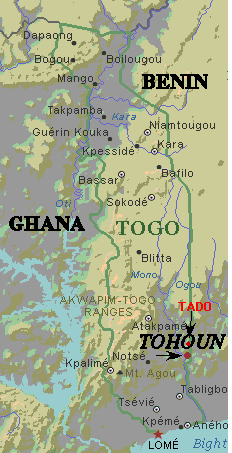 |
HISTORYTado is the birthplace of the Adja-Ewé people; an ethnic group which populates the South of Togo and Benin. A long time ago the village was called "EZAME". In the Adja language, Eza is the name of a tree. Thus Ezamé means "planted with Eza trees". At a given moment in its history, the village suffered from several misfortunes. There was infant mortality, drought, and famine. These difficult moments coincided with the arrival of a man name TOGBUI-ANYI. This man proposed to the village that he cure it of all ills on the condition that they accept him as king. His proposal was accepted. Using his magical powers, the stranger cured the village of its ills. He thus became king of the kingdom. From then he changed the name of the village which then become "TADO" which means "to step over". According to the new king, all the misfortunes are going to skip over the kingdom. Each year the Adja of Tado celebrate this deliverance during the current month of August. This holiday is named "TOGBUI-ANYI Day". The 186th king is currently in power. During this holiday, the Adja-Ewé from Togo, Benin, and Ghana come back to Tado, their common ancestral home, to pray to their ancestral spirits in order to have plentiful rain and good health. DAILY ACTIVITIES--FarmingThe primary activity of most inhabitants of Tado is agriculture. This agriculture is not mechanized and the tools still currently in use are the hoe, macheté , and the "daba". Very few people use livestock to plow. The crops grown are: corn, peanuts, beans, yams, manioc, and cotton. |
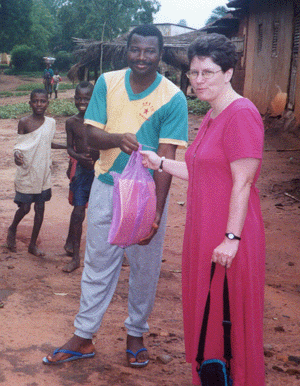
|
The village of Tado has four primary schools and two junior high schools. Of the six schools located in Tado, there are two schools, a primary school and a junior high school, which suffer from inadequate facilities. These are "paillotes" or "apatames" made of branches for supports and thatched roofs which serve as classrooms. Shown here is the C. E. G. de Tado (Tado Jr. High School) with Susan, the school principal and the English teacher. Susan visited the newest Junior High School in the region in Tado, just North of Tohoun. Here she is visiting a class with the Principal and an English teacher. In grades 6 through 9 students study French, English, Social Studies, Biology, Math, and Physical Sciences. To enter high school these students need to pass a national examination called the "BEPC". Math and Social Studies teachers have used the new globe in their lessons, and students cleared an area for soccer games during the Spring of 2000. |
|
The school's mailing address is: C. E. G. de Tado s/c College Protestant de Tado B. P. 15 Tohoun Moyen Mono Togo, West Africa. |
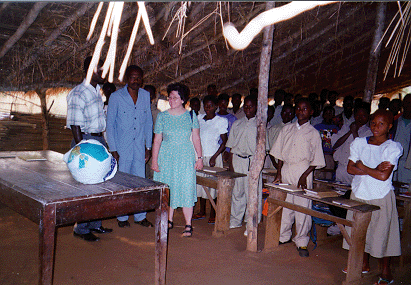 |
With a population of more than 2000 inhabitants, Tado only has one dispensary which serves as a health center. This forces the inhabitants to seek treatment in the well-equipped health centers in Benin, the neighboring country. |
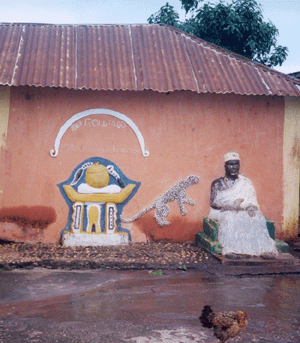
|
Miscellaneous Facilities and Activities
|
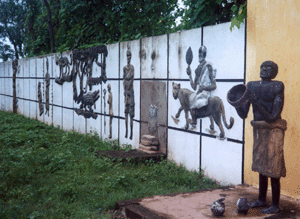
|
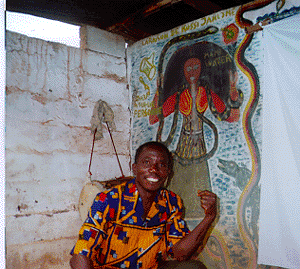
|
Finally, in conclusion, the inhabitants of Tado like community work projects which help in development of their region. Their wish is for this village to become paired (Twin City) with a town in Europe or America in order to share their culture and civilization.
They hope you will help them in whatever ways are feasible.